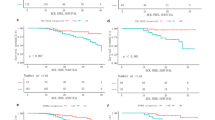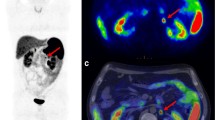Abstract
Purpose
To investigate and validate the prognostic value of nomogram models for predicting disease-free survival (DFS) and overall survival (OS) in patients with clear cell renal cell carcinoma (ccRCC).
Methods
In this retrospective study, 223 patients (age 54.38 ± 10.93 years) with pathologically confirmed ccRCC who underwent resection and lymph node dissection between March 2010 and September 2018 were investigated. All patients were randomly divided into training (n = 155) and validation (n = 68) cohorts. Radiomics features were extracted from computed tomography (CT) images in the unenhanced, corticomedullary, and nephrographic phases. Radiomic score was calculated and combined with clinicopathological factors for model construction and nomogram development. Clinicopathological factors and imaging features were collected at initial diagnosis. Univariate and multivariate Cox proportional hazards regression analyses were used to evaluate the relationship between the radiomics signature and prognosis outcomes.
Results
There were four prognostic factors for predicting DFS and five factors for predicting OS in our nomogram model (P < 0.05). The radiomics signature correlated independently with DFS (hazard ratio = 27; P < 0.001) and OS (hazard ratio = 25; P < 0.001). The nomogram showed excellent performance (C-index = 0.825) for predicting DFS. The combined nomogram also showed the highest C-index for OS (C-index = 0.943), which was verified in the validation dataset.
Conclusion
The combined nomogram model based on radiomics, clinicopathological factors, and preoperative CT features can accurately perform prognosis and survival analysis and can potentially be used for preoperative non-invasive survival prediction in ccRCC patients.








Similar content being viewed by others
Data availability
The datasets generated/analyzed in this article are available from the corresponding author on reasonable request.
References
Siegel RL, Miller KD, Jemal A (2020) Cancer statistics, 2020. CA Cancer J Clin 70:7–30. https://doi.org/10.3322/caac.21590
Brufau BPO, Cerqueda CS, Villalba LB, Izquierdo RS, González BM, Molina CN (2013) Metastatic renal cell carcinoma: radiologic findings and assessment of response to targeted antiangiogenic therapy by using multidetector CT. Radiographics 33:1691–1716. https://doi.org/10.1148/rg.336125110
Young JR, Margolis D, Sauk S, Pantuck AJ, Sayre J, Raman SS (2013) Clear cell renal cell carcinoma: discrimination from other renal cell carcinoma subtypes and oncocytoma at multiphasic multidetector CT. Radiology 267:444–453. https://doi.org/10.1148/radiol.13112617
Capitanio U, Montorsi F (2016) Renal cancer. Lancet 387:894–906. https://doi.org/10.1016/S0140-6736(15)00046-X
Wang Z, Xie H, Guo L, Cai Q, Shang Z, Jiang N, Niu Y (2017) Prognostic and clinicopathological value of Ki-67/MIB-1 expression in renal cell carcinoma: a meta-analysis based on 4579 individuals. Cancer Manag Res 9:679–689. https://doi.org/10.2147/CMAR.S141670
Ljungberg B, Albiges L, Abu-Ghanem Y, et al. (2019) European Association of Urology guidelines on renal cell carcinoma: the 2019 update. Eur Urol 75:799–810. https://doi.org/10.1016/j.eururo.2019.02.011
Ding J, Xing Z, Jiang Z, Chen J, Pan L, Qiu J, Xing W (2018) CT-based radiomic model predicts high grade of clear cell renal cell carcinoma. Eur J Radiol 103:51–56. https://doi.org/10.1016/j.ejrad.2018.04.013
Zhou L, Zhang Z, Chen YC, Zhao ZY, Yin XD, Jiang HB (2019) A deep learning-based radiomics model for differentiating benign and malignant renal tumors. Transl Oncol 12:292–300. https://doi.org/10.1016/j.tranon.2018.10.012
Jiang Y, Li W, Huang C, et al. (2020) A computed tomography-based Radiomics nomogram to preoperatively predict tumor necrosis in patients with clear cell renal cell carcinoma. Front Oncol 10:592. https://doi.org/10.3389/fonc.2020.00592
Liu Q, Li J, Liu F, Yang W, Ding J, Chen W, Wei Y, Li B, Zheng L (2020) A radiomics nomogram for the prediction of overall survival in patients with hepatocellular carcinoma after hepatectomy. Cancer Imaging 20:82. https://doi.org/10.1186/s40644-020-00360-9
Choe J, Lee SM, Do KH, Kim S, Choi S, Lee JG, Seo JB (2020) Outcome prediction in resectable lung adenocarcinoma patients: value of CT radiomics. Eur Radiol 30:4952–4963. https://doi.org/10.1007/s00330-020-06872-z
Klatte T, Rossi SH, Stewart GD (2018) Prognostic factors and prognostic models for renal cell carcinoma: a literature review. World J Urol 36:1943–1952. https://doi.org/10.1007/s00345-018-2309-4
Frank I, Blute ML, Cheville JC, Lohse CM, Weaver AL, Zincke H (2002) An outcome prediction model for patients with clear cell renal cell carcinoma treated with radical nephrectomy based on tumor stage, size, grade and necrosis: the SSIGN score. J Urol 168:2395–2400. https://doi.org/10.1016/S0022-5347(05)64153-5
Collewet G, Strzelecki M, Mariette F (2004) Influence of MRI acquisition protocols and image intensity normalization methods on texture classification. Magn Reson Imaging 22:81–91. https://doi.org/10.1016/j.mri.2003.09.001
Zwanenburg A, Vallières M, Abdalah MA, et al. (2020) The Image Biomarker Standardization Initiative: standardized quantitative radiomics for high-throughput image-based phenotyping. Radiology 295:328–338. https://doi.org/10.1148/radiol.2020191145
Kang L, Chen W, Petrick NA, Gallas BD (2015) Comparing two correlated C indices with right-censored survival outcome: a one-shot nonparametric approach. Stat Med 34:685–703. https://doi.org/10.1002/sim.6370
Bi WL, Hosny A, Schabath MB, et al. (2019) Artificial intelligence in cancer imaging: Clinical challenges and applications. CA Cancer J Clin 69:127–157. https://doi.org/10.3322/caac.21552
Lee HS, Oh JS, Park YS, Jang SJ, Choi IS, Ryu JS (2016) Differentiating the grades of thymic epithelial tumor malignancy using textural features of intratumoral heterogeneity via 18F-FDG PET/CT. Ann Nucl Med 30:309–319. https://doi.org/10.1007/s12149-016-1062-2
Lambin P, Rios-Velazquez E, Leijenaar R, Carvalho S, van Stiphout RG, Granton P, Zegers CM, Gillies R, Boellard R, Dekker A, Aerts HJ (2012) Radiomics: Extracting more information from medical images using advanced feature analysis. Eur J Cancer 48:441–446. https://doi.org/10.1016/j.ejca.2011.11.036
Gillies RJ, Kinahan PE, Hricak H (2016) Radiomics: images are more than pictures, they are data. Radiology 278:563–577. https://doi.org/10.1148/radiol.2015151169
Ji GW, Zhu FP, Xu Q, Wang K, Wu MY, Tang WW, Li XC, Wang XH (2020) Radiomic features at contrast-enhanced CT predict recurrence in early stage hepatocellular carcinoma: A multi-institutional study. Radiology 294:568–579. https://doi.org/10.1148/radiol.2020191470
Zisman A, Pantuck AJ, Dorey F, Chao DH, Gitlitz BJ, Moldawer N, Lazarovici D, deKernion JB, Figlin RA, Belldegrun AS (2002) Mathematical model to predict individual survival for patients with renal cell carcinoma. J Clin Oncol 20:1368–1374. https://doi.org/10.1200/JCO.2002.20.5.1368
Limkin EJ, Reuzé S, Carré A, Sun R, Schernberg A, Alexis A, Deutsch E, Ferté C, Robert C (2019) The complexity of tumor shape, spiculatedness, correlates with tumor radiomic shape features. Sci Rep 9:4329. https://doi.org/10.1038/s41598-019-40437-5
Shu J, Tang Y, Cui J, Yang R, Meng X, Cai Z, Zhang J, Xu W, Wen D, Yin H (2018) Clear cell renal cell carcinoma: CT-based radiomics features for the prediction of Fuhrman grade. Eur J Radiol 109:8–12. https://doi.org/10.1016/j.ejrad.2018.10.005
Motzer RJ, Jonasch E, Michaelson MD, et al. (2019) NCCN Guidelines Insights: Kidney Cancer, Version 2.2020. J Natl Compr Canc Netw 17:1278–1285. https://doi.org/10.6004/jnccn.2019.0054
Delahunt B, Eble JN, Egevad L, Samaratunga H (2019) Grading of renal cell carcinoma. Histopathology 74:4–17. https://doi.org/10.1111/his.13735
Park YH, Baik KD, Lee YJ, Ku JH, Kim HH, Kwak C (2012) Late recurrence of renal cell carcinoma >5 years after surgery: clinicopathological characteristics and prognosis. BJU Int 110:E553–E558. https://doi.org/10.1111/j.1464-410X.2012.11246.x
Arun I, Maity N, Hameed S, Jain PV, Manikantan K, Sharan R, Arun P (2021) Lymph node characteristics and their prognostic significance in oral squamous cell carcinoma. Head Neck 43:520–533. https://doi.org/10.1002/hed.26499
Tsili AC, Argyropoulou MI, Gousia A, Kalef-Ezra J, Sofikitis N, Malamou-Mitsi V, Tsampoulas K (2012) Renal cell carcinoma: value of multiphase MDCT with multiplanar reformations in the detection of pseudocapsule. Am J Roentgenol 199:379–386. https://doi.org/10.2214/AJR.11.7747
Yang X, Pan X, Liu H, Gao D, He J, Liang W, Guan Y (2018) A new approach to predict lymph node metastasis in solid lung adenocarcinoma: a radiomics nomogram. J Thorac Dis 10:S807–S819. https://doi.org/10.21037/jtd.2018.03.126
Li S, Tang BY, Zhang B, Wang CP, Zhang WB, Yang S, Chen JB (2019) Analysis of risk factors and establishment of a risk prediction model for cardiothoracic surgical intensive care unit readmission after heart valve surgery in China: A single-center study. Heart Lung 48:61–68. https://doi.org/10.1016/j.hrtlng.2018.07.013
Yang R, Wu J, Sun L, Lai S, Xu Y, Liu X, Ma Y, Zhen X (2020) Radiomics of small renal masses on multiphasic CT: accuracy of machine learning–based classification models for the differentiation of renal cell carcinoma and angiomyolipoma without visible fat. Eur Radiol 30:1254–1263. https://doi.org/10.1007/s00330-019-06384-5
Li ZC, Zhai G, Zhang J, Wang Z, Liu G, Wu GY, Liang D, Zheng H (2019) Differentiation of clear cell and non-clear cell renal cell carcinomas by all-relevant radiomics features from multiphase CT: a VHL mutation perspective. Eur Radiol 29:3996–4007. https://doi.org/10.1007/s00330-018-5872-6
Hu J, Chen J, Li H, He T, Deng H, Gong G, Cui Y, Liu P, Ren W, Zhou X, Li C, Zu X (2020) A preoperative nomogram predicting the pseudocapsule status in localized renal cell carcinoma. Transl Androl Urol 9:462–472. https://doi.org/10.21037/tau.2020.01.26
Acknowledgements
We would like to thank Editage (www.editage.com) for the English language editing service.
Funding
This work was supported by the Natural Science Foundation of Shandong [Grant Number NO. ZR2020MH289] and the Academic promotion program of Shandong First Medical University [Grant Number 2019QL023].
Author information
Authors and Affiliations
Contributions
All authors contributed to the study conception and design. Material preparation, data collection, and analysis were performed by YM, XC, HZ, and JX. The first draft of the manuscript was written by Ying Ming and all authors read and approved the final manuscript. Conceptualization: ZH and JZ; Methodology: YM, HZ, and TM; Formal analysis and investigation: YM and XC; Software: JX and CH; Validation: JX; Visualization: YM, XC, and ZL; Writing—original draft preparation: YM; Writing—review and editing: XC, JZ, and ZH; Supervision: ZH.
Corresponding author
Ethics declarations
Conflict of interest
The authors have no conflicts of interest to declare that are relevant to the content of this article.
Ethical approval
The study was performed in line with the principles of the Declaration of Helsinki. Approval was granted by the Ethics Committee of Shandong Provincial Hospital (Date2021-07-07/ No. 2021-257).
Consent to participate
The requirement for informed consent was waived due to the retrospective nature of the study.
Consent for publication
Not applicable.
Additional information
Publisher's Note
Springer Nature remains neutral with regard to jurisdictional claims in published maps and institutional affiliations.
Rights and permissions
About this article
Cite this article
Ming, Y., Chen, X., Xu, J. et al. A combined postoperative nomogram for survival prediction in clear cell renal carcinoma. Abdom Radiol 47, 297–309 (2022). https://doi.org/10.1007/s00261-021-03293-4
Received:
Revised:
Accepted:
Published:
Issue Date:
DOI: https://doi.org/10.1007/s00261-021-03293-4




